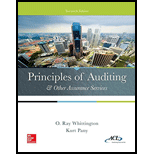
a.
Calculate the planned assessed level of control risk.
a.
Explanation of Solution
Control risk:
Inherent risk is a risk of misstatement of the financial statements due to the factors the failure of internal control. Company establishes an internal control department to detect the misstatement in the financial statements of the company due to error or fraud. When the internal control of the company is not able to find out the mistaken then it is known as control risk because company has control effectiveness issues.
Planned assessment of control risk:
It is the level of control risk (misstatement because of loose internal control) at which the auditor intent to consider in a given financial statement assertion.
Calculate the planned assessed level of control risk:
Planned assessed level of control risk is the level of risk at which the auditor does not consider the misstatement as a material misstatement. In the given case, the tolerable deviation rate of 4% can be considered as a planned assessed level of control risk.
Thus, the planned assessed level of control risk is 4%.
b.
Calculate the appropriate
b.
Explanation of Solution
Sample size:
The sample size is the portion of the total population that represents the total population. The auditor conducts sampling test on the selected sample. Large sample size would represent the population more accurately but considering a large sample size would be a complex and expensive process. The auditor should select the sample size that would represent the entire population precisely and accurately.
Expected population deviation rate:
Expected population deviation rate is the estimated failure rate of control in the population. This prediction is done by the auditor. The estimation is based on the results of the primary sampling, last year’s sample testing, inquiries by the client and process observation. It is required to determine the level of sample size needed in the
Calculate the appropriate sample size:
Input:
Output:
Thus, the required sample size is 119 units.
c.
Estimate the achieved upper deviation rate and suggest the assessed level of control risk for the given circumstances.
c.
Explanation of Solution
Tolerable misstatement:
It is the limit of the misstatement that the client company can accept. Tolerable misstatement is lower than the material misstatement. If the misstatement goes above tolerable misstatement then the management has to consider the test of control.
Expected population deviation rate:
Expected population deviation rate is the estimated failure rate of control in the population. This prediction is done by the auditor. The estimation is based on the results of the primary sampling, last year’s sample testing, inquiries by the client and process observation. It is required to determine the level of sample size needed in the audit sampling process.
Planned assessment of control risk:
It is the level of control risk (misstatement because of loose internal control) at which the auditor intent to consider in a given financial statement assertion.
C1
Input:
Output:
The achieved upper deviation rate at the sample size of 119 units and 0 deviations is 2.52%.
Thus, the achieved upper deviation rate is 2.52%.
C2
Input:
Output:
The achieved upper deviation rate at the sample size of 119 units and 1 deviation is 3.99%.
Thus, the achieved upper deviation rate is 3.99%.
C3
Input:
Output:
The achieved upper deviation rate at the sample size of 119 units and 8 deviations is 12.13%.
Thus, the achieved upper deviation rate is 12.13%.
C4
Input:
Output:
The achieved upper deviation rate at the sample size of 119 units and 0 deviations is 2.52%.
Thus, the achieved upper deviation rate is 2.52%. The assessed level of control risk is low as it is less than tolerable level.
C5
Input:
Output:
The achieved upper deviation rate at the sample size of 119 units and 1 deviation is 3.99%.
Thus, the achieved upper deviation rate is 3.99%. The assessed level of control risk is low as it is less than tolerable level.
C6
Input:
Output:
The achieved upper deviation rate at the sample size of 119 units and 8 deviations is 12.13%.
Thus, the achieved upper deviation rate is 12.13%.
Thus, the planned level of control risk is slightly below the maximum in case of 8 deviations.
Want to see more full solutions like this?
Chapter 9 Solutions
Principles of Auditing & Other Assurance Services (Irwin Accounting)

 AccountingAccountingISBN:9781337272094Author:WARREN, Carl S., Reeve, James M., Duchac, Jonathan E.Publisher:Cengage Learning,
AccountingAccountingISBN:9781337272094Author:WARREN, Carl S., Reeve, James M., Duchac, Jonathan E.Publisher:Cengage Learning, Accounting Information SystemsAccountingISBN:9781337619202Author:Hall, James A.Publisher:Cengage Learning,
Accounting Information SystemsAccountingISBN:9781337619202Author:Hall, James A.Publisher:Cengage Learning, Horngren's Cost Accounting: A Managerial Emphasis...AccountingISBN:9780134475585Author:Srikant M. Datar, Madhav V. RajanPublisher:PEARSON
Horngren's Cost Accounting: A Managerial Emphasis...AccountingISBN:9780134475585Author:Srikant M. Datar, Madhav V. RajanPublisher:PEARSON Intermediate AccountingAccountingISBN:9781259722660Author:J. David Spiceland, Mark W. Nelson, Wayne M ThomasPublisher:McGraw-Hill Education
Intermediate AccountingAccountingISBN:9781259722660Author:J. David Spiceland, Mark W. Nelson, Wayne M ThomasPublisher:McGraw-Hill Education Financial and Managerial AccountingAccountingISBN:9781259726705Author:John J Wild, Ken W. Shaw, Barbara Chiappetta Fundamental Accounting PrinciplesPublisher:McGraw-Hill Education
Financial and Managerial AccountingAccountingISBN:9781259726705Author:John J Wild, Ken W. Shaw, Barbara Chiappetta Fundamental Accounting PrinciplesPublisher:McGraw-Hill Education





